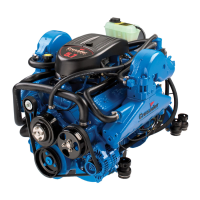26
L510023-07
ENGINE COMPARTMENT VENTILATION
USCG & ABYC Standards
United States Coast Guard regulations (33 CFR Section
183, subpart J & K) must be adhered to in any fuel and
ventilation system installation. In addition, we strongly
suggest that ABYC’s recommendations regarding fuel
systems and engine room ventilation be followed.
Care must be exercised in the design and construction
of the engine compartment. Hatch openings must be
located so that any rain water, which may leak through
the seams, is directed away from the engine. If water
enters the fl ame arrestor, it can enter the engine and
cause serious damage to internal engine parts.
IMPORTANT: Crusader Engines will not honor any
warranty claim for engine damage as a result of
water entry.
Over the past several years, engine compartments have
been made smaller and insulated to be quieter. This
trend, while resulting in quieter boats, has resulted in
higher engine compartment temperatures. It is important
that attention be given to the air temperatures inside
the engine compartment while running and for a period
of time after the engine is shut off. This period of time
after shutting off the engines is critical as temperatures
normally rise (heat soak) and can lead to fuel vapor lock
causing the engine startability problems.
Engine compartment must be designed to provide a
suffi cient volume of air for engine breathing, and must
vent off any fumes in engine compartment. It should
also be designed to allow heated air to escape and
maintain low temperatures during engine operation.
Cool air should enter the engine compartment as low as
possible and heated air should be vented from as high a
point as possible.
IMPORTANT: The size of ventilation opening must
be increased if any auxiliary equipment, such as
generators, is located in the engine compartment.
ENGINE AIR REQUIREMENTS
AT WIDE-OPEN-THROTTLE
Model Volume
MP 5.0L 670 ft
3
/min (0.320 m
3
/sec)
MP 5.7L 670 ft
3
/min (0.320 m
3
/sec)
MP 6.0L 670 ft
3
/min (0.320 m
3
/sec)
MP 8.1L STD 697 ft
3
/min (0.329 m
3
/sec)
MP 8.1L HO 697 ft
3
/min (0.329 m
3
/sec)
Air requirements listed are for single engine and
must be doubled for dual engine installations.
The pressure differential (outside engine compartment
versus inside engine compartment) should not exceed
2 in. (51 mm) of water (measured with a manometer) at
wide open throttle.
Engine Compartment & Fuel Temperature Testing
capable of operation throughout an ambient (air
temperature) range from 20° to 150°F (-7° to 65°C)
without failure. Crusader EFI and associated
components meet this standard.
Because electronic fuel injection systems require
higher fuel delivery pressures and higher volumes, fuel
temperatures become an issue. Engine compartment
temperatures have been measured in excess of 200°F
(82°C). High fuel temperatures may lead to excessive
vapor in the fuel line, particularly when gasoline
containing alcohol and the newer “reformulated” blends
are used. A maximum fuel temperature at the fuel
pump inlet of 105°F (40°C) and an ambient engine room
temperature of 150°F (65°C) must be adhered to.
To test for ambient air and fuel inlet temperature
compliance, proceed as follows:
The boat being tested should be a standard production
boat. The temperature meter used must be of a type
which can be read with the engine compartment closed.
The engine compartment is to remain closed and no air
is to be forced into the engine compartment during the
test. The bilge blower should not be running.
A. Install thermal couples 1 in. (25 mm) above each
fl ame arrestor for air temperature measurement.
B. Tee another thermal couple into the fuel line(s)
at the fuel pump inlet for measuring fuel
temperature.
C. Operate the engine(s) until engine and bilge
temperatures are stabilized. This usually
occurs when operating the engine under cruise
conditions for a minimum of one hour.
D. Shut engine(s) off and monitor temperatures
for an additional hour. Air temperature should
not exceed 150°F (65°C) and fuel temperature
should not exceed 105°F (40°C) at any time,
either during engine operation or engine off (hot
soak).
E. After the one hour hot soak test, start the
engine and let it idle (in neutral) for 20 minutes.
Continue to record temperatures for another 20
minutes.
If temperature limits are exceeded at any time during
this test, it is necessary to reevaluate the fuel system
and/or bilge ventilation and take appropriate measures
to maintain temperatures at or below the specifi ed limits
at all times.

